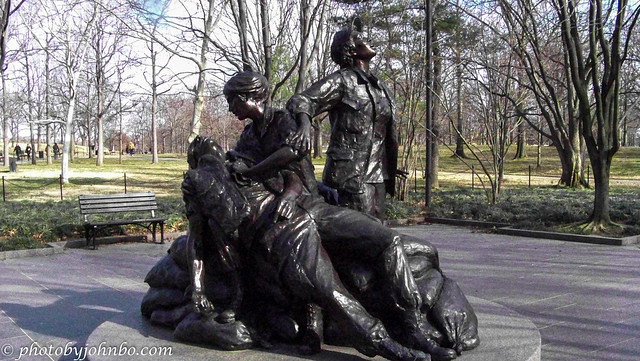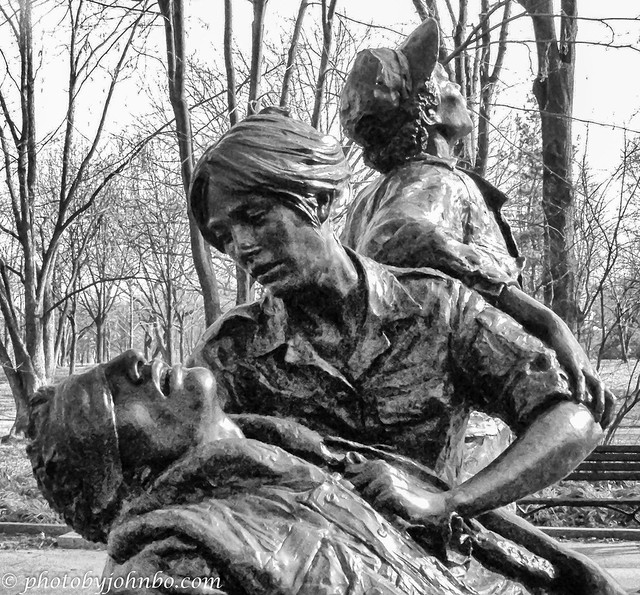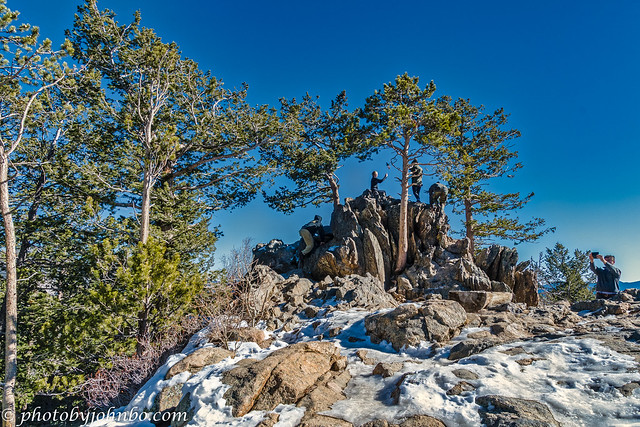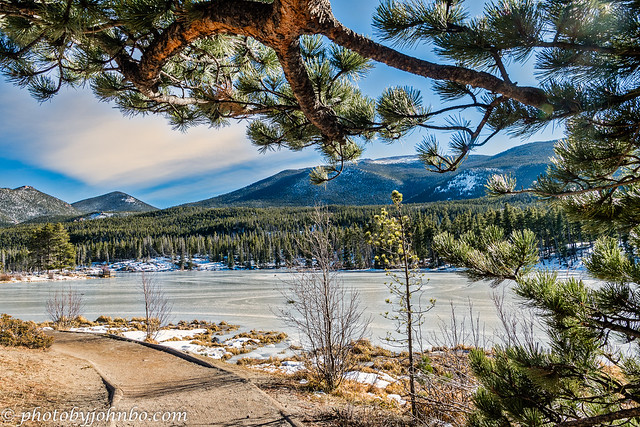
This week, Patti suggests that we tell the whole story with our cameras. She writes, “I’ve discovered that moving closer to the subject often reveals surprising details that enrich the photo. When the subject fills the frame (occupies a large portion of the image), I can also eliminate distracting or unnecessary elements in the background, and add more drama to my image.”
Patti concludes her post with this challenge, “For LAPC #190, we challenge you to move closer to your subject. Post one photo or a series of photos showing what happened when your subject filled the frame. Did this reveal new details? Did this eliminate distracting or unnecessary elements in the photo? Did this add more drama or empathy to your image? Get closer by moving your feet, by using a zoom or macro lens, or by cropping the photo.” You can read her entire challenge post here.
When I went on safari in Africa, I got a little too close to the wild hogs… it’s best to keep your distance and use the zoom lens. OK, so I didn’t go to Africa, I visited the Denver Museum of Nature and Science in Colorado. Their dioramas of taxidermied animals are large enough to put you right in the middle of the action.
Stepping back, the image tells a larger story of wildlife in Africa. From my high school journalism and photography classes, I learned to tell the story by using wide-angle, midrange, and close-up shots.
You can get a better sense of the size of this diorama from the view in the image above. Note, though, that the scene is actually larger than the frame around the diorama. You can tell that by comparing the midrange shot with the wide-angle view. Note that in the wide-angle shot, you can only see one zebra. By walking closer to the display and looking to the right, you can see there are three adult zebras and a juvenile. If you look closely in the lower right corner of the mid-range image, I missed cropping out part of the diorama frame.
Near the Viet Nam Memorial Wall, there is a 15-foot (4.5 m) tall statue depicting two nurses tending to a wounded soldier. The establishing shot above provides a view of the entire sculpture for context and placement in the park.
Moving closer and focusing on the subjects, the compassion in the face of the nurse is easy to see. The other nurse is scanning the sky looking for the chopper that is on the way in to pick up the wounded soldier. At least, that’s what I imagine is happening in the story. Converting the image to black-and-white added some drama and a bit more realism to the image as color newsreel coverage of the war was still quite rare in those years.
On a visit to Rocky Mountain National Park, we happened upon this viewpoint. A group of young adults was climbing the rock outcropping to get a better view of the scenery below.
After walking to the left, I could see it was time for a photo. This image tells the viewer that the location is good for capturing selfie photos. It is also a location where a person needs to be careful in framing and posing. A wrong step could end up in a much more tragic story.
Also in Rocky Mountain National Park, Sprague Lake was not yet completely frozen over in this image from mid-November. I actually combined two images to create a panorama that was still too small to cover the entire lake, but it did capture an unusual cloud formation near one of the peaks in the background.
From that establishing shot, I proceeded to walk the path around the lake capturing several views up-close. This shot was my favorite of the group, the tree creating a natural frame, and though partially obscured, in my opinion, that unusual cloud formation is even more interesting from this view.
In North Platte, Nebraska, a large memorial is dedicated to 20th Century Nebraska veterans. Each of the sculptures depicts a real person, a veteran who lived in Nebraska and was called to serve in the armed forces between 1900 and 1999. This establishing shot features three soldiers in the foreground and the rows of bricks, each labeled with the name of a Nebraska veteran. Other statues depict Nebraskans in each branch of service to our country.
Moving in for a closer look at the statue, my favorite composition featured the American flag in the background. This shot required a bit of Photoshop “trickery” to remove a large light from the final image. Though the pole was easily cropped, the light and its support were both visible in the cropped image. You can see that light on the right in the establishing shot.
You can pixel-peep any of these images in 2K HD on my Flickr site by simply clicking on the image. You can view the entire album here.
Thanks to Patti for providing a platform for me to share a few of my favorite subjects with both establishing and close-up shots. Next week, Ann-Christine will be the host for the Lens-Artist Challenge in just a couple of days, Saturday, March 19, 2022.
John Steiner
Postscript: This post marks nine years since I created an account on WordPress to begin Journeys with Johnbo. The first story published was on March 18, 2013. Happy Blogversary to me!! >grin<











Happy Blogversary!
Thanks!
Hearty congratulations.
Not an easy job.
It gives inspiration to rest of us and that blogging (regularly)need not be intimidating.
Love your explanation of
wide-angle, midrange, and close-up shots along with those shots of diorama.
Thanks, Philo. I try hard to stick to three posts a week, and it’s very helpful that my topics are flexible in timing so that I can create and schedule future posts for when I have to take a few days off.
Those lessons about journalistic photography I learned in high school and they stuck with me all these many years.
Thank you John.
Three posts a week is a good choice and one can utilise the available time for proper planning of choice of the posts.
This is the 2 nd successive year for me to post articles daily and this year(2021-2022)so far 272 posts .
I just wanted to check my ability to post 1-3 posts daily so that posting at least one post for 365 days.(a sort of challenging my self)
That’s certainly an ambitious schedule, Philo. I have noticed how regularly you post while scanning my daily reader.
Thank you John.
People like you are my inspiration indeed!
🙏🙏🙏
Wonderful photos, John. I like all of them but especially the Sprague Lake ones. You always do such an amazing job to stitch panoramas. 9 years is very respectable, Happy Blogversary! I wonder if I’ll last that long 🙂
Thanks, Sofia. I do enjoy creating panoramas. When I’m out in the field, I am always looking for interesting compositions that lend themselves to a widescreen format. Lightroom is the magic behind the stitching. It seldom errors when stitching two images as long as there is a common point in each image.
Interesting. I’ve only tried a couple of times but always on Photoshop. I’ll give Lightroom a try too.
Happy Blogversary ! You started about 1 month before me!
Happy Blogversary to you as well, Aletta!
Thanks! 😀
Great photos for the challenge. Happy Blogversary! Your blog is two days older than mine!
Happy Blogversary to you as well! Thanks!!
Happy Blogversary, and what a great post with which to celebrate – you really captured the spirit of Patti’s challenge 🙂
Thanks, Sarah! I like the concept of establishing and going in close, and use it regularly, so I truly have hundreds of examples.
Congratulations and to many years to come on WP. The image of Sprague Lake is amazing.
Thanks, my friend! Sprague Lake is beautiful all year long, but it is especially beautiful after the first snow falls and with ice starting to form.
Excellent, John. The B&W closeup is my fave.
Thanks, John!
I love this post John. Your creativity came out with the cropping of the museum diorama, your sensitivity with the women’s war memorial, your composition ability with the Sprague Lake images. Oh and congratulations on your Blogversary!
Thank you, Anne! I truly appreciate the compliments.
You’re welcome and you earned them!
[…] From John Lens Artists Weekly Photo Challenge 190: Close and Closer. […]
Hi John
Love your sense of humor and the clever way you used those dioramas to illustrate close and closer! Your close-up of the Women’s Memorial shows anguish so eloquently it felt palpable. Excellent.
Here’s my offering for LAPC 190: Close and Closer
Best, Babsje
Thank you, Babsje. I enjoyed your post, and I especially like your “bumper sticker.”
Happy Blogversary! Thanks for all the interesting and well illustrated articles!
Thanks and you are welcome! I hope to be doing them for a few more years anyway. 🙂
And I hope to be reading them for a few more years also. 🙂
Happy Blogversary, John!! I love the photos of the lake.
janet
Happy blogaversary! Your post is wonderful. I was so moved by the nurses’ statue in D.C. You did a great job of setting the context and zooming in on the faces. My favorite though is Sprague Lake. Your shots are gorgeous!
Thank you, Patti! Sprague Lake is gorgeous any time of year.
you KNOW I loved Sprague Lake! So pristine, calm and quiet I imagine.
Thank you for including the Vietnam Memoria of the nurses. So important to capture the faces to “feel” the emotions that comes from it. Such a reflective place. Brought me to tears more than once. Very nice. Hope your travel is going well Donna
That memorial, and indeed the other memorials in that park are heart-wrenching.
LOL for trickery John – I might call it image editing but hey, whatever!! Wonderful example your lake images.s but I was really captured by the final image. I think it’s wonderful that they used actual veterans. Super! Also loved
It’s all magic to me. 🙂
Sorry, hit enter by error. Loved both of the lake images
Excellent selections, Joh! The Women’s Memorial close-up is quite movng. Love your landscape photos. Great capture of the Nebraska Veterans Memorial!
Thanks, Amy! The sculptor put so much life in those faces. It is truly moving.
Really great pictures, John, and a nice variety. Sprague Lake looks beautiful, love your pictures of it. Happy Blogversary!
Thanks, Sylvia. Sprague Lake is beautiful any time of the year, but especially in winter.